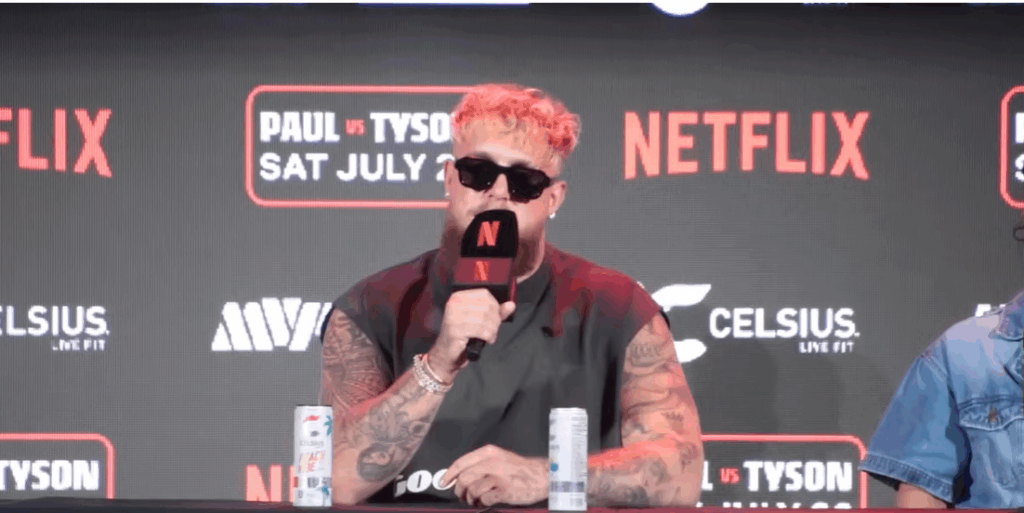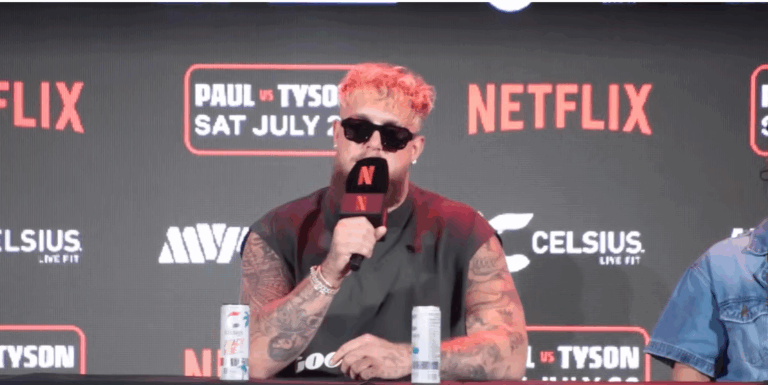The fact that Jake Paul recently weighed 227 pounds before taking on Mike Tyson wasn’t an accident; rather, it was a planned performance. He positioned himself as a legitimate heavyweight by purposefully gaining two stone, or more than 40 pounds, which attracted the attention of both sports commentators and fans. Even the most doubtful onlookers questioned whether he was sacrificing his agility for a publicity stunt due to his obvious weight gain, which was caused by consuming large amounts of steak, pasta, and potatoes. That precise bulk-up has recently emerged as a central theme in meme culture and sports media.
Jake reinforced that narrative by using a fat suit in his training advertisements. In addition to arousing interest, it also sparked derision and viral discussion, which he is especially adept at turning into pay-per-view purchases. Jake leaned into the caricature while lifting foam weights and wearing a prosthetic belly, blurring the boundaries between reality and performance. The responses were quick and divisive. Never one to hold back, Mike Tyson called him “fat,” which only served to increase the spectacle’s exposure.
The approach bears a striking resemblance to WWE-style entertainment branding for anyone who is familiar with the Paul brothers’ ascent. Jake is skilled at creating buzz by framing his fights theatrically rather than just by being a great boxer. Whether true or fabricated, this fat narrative was a well-timed play. He produced a spectacle that effectively captured the interest of both ardent boxing fans and casual viewers perusing social media by fusing comedy and spectacle.
Jake Paul – Bio and Career Snapshot
| Full Name | Jake Joseph Paul |
|---|---|
| Date of Birth | January 17, 1997 |
| Age | 28 |
| Nationality | American |
| Profession | YouTuber, Boxer, Influencer, Entrepreneur |
| Weight Class | Cruiserweight (200 lbs) / Former Heavyweight |
| Highest Recorded Weight | 227 lbs (Tyson Fight Training) |
| Notable Fights | Mike Tyson, Tommy Fury, Nate Diaz |
| Business Ventures | Most Valuable Promotions, content brands |
| Notable Trend | Dramatic weight transformation in 2025 |
| Official Source | https://www.thesun.co.uk/sport/22922880/jake-paul-heavyweight-fat-tyson/ |

However, the weight gain’s real effects were noticeably less humorous. The 227-pound frame felt “too much” for Jake, who later acknowledged that he was slow in the ring. His body wasn’t built for the heavyweight class, he admitted. Despite being purposefully gained, the extra pounds greatly decreased his speed and endurance, especially in later rounds. His cruiserweight baseline, weighing about 200 lbs, was found to be a better fit for peak performance.
Jake returned to a lower weight class following the Tyson fight in an effort to find his comfort level. This comeback signaled a change in marketing tone as well as physical appearance. The fat suit’s burlesque humor had vanished. He was now focused, slender, and sculpted, prepared to take on new rivals like Julio Cesar Chavez Jr. His return to cruiserweight was a deliberate attempt to strike a balance between showmanship and performance.
Jake’s ability to influence perceptions across platforms was especially creative. By donning a fat suit and lifting fictitious weights, he brought his body into the discussion, serving as both a training routine and a moment that inspired memes. The layers behind his stunt were exposed by Reddit users who obsessively examined the videos, pointing out missing tattoos and foam weights. “You’d think the lack of nipples would give it away,” said one Redditor. These specifics fueled the buzz machine rather than harming his brand.
Jake’s every action is magnified by strategic alliances and cross-promotions with DAZN and Netflix. Even seasoned pros rarely reach the 100 million views that his fight with Tyson garnered. His brand especially benefits from the fact that even his distorted or exaggerated body image can be turned into revenue. Unlike traditional fighters like Canelo Alvarez or Gervonta Davis, who may sell fights on skill but rarely on irony, he has adopted a distinctively postmodern marketing strategy.
Jake’s use of humor and body transformation is more than just physical; it’s a statement in the context of digital celebrity. Younger millennials and Gen Z have a flexible definition of authenticity. Preemptive trolling, which turns ridicule into authority, is when someone wears a fat suit to make fun of the criticism they are getting. The same tactic has been used by influencers who use self-awareness as armor, such as Logan Paul, Lil Nas X, and even Doja Cat.
Jake creates a persona that is remarkably resilient by alternating between commitment and derision with ease. The narrative is still in his hands, whether he’s fighting Tyson or making Reddit memes. This adaptability in turning public opinion into entertainment shows how adaptable athletes have become in the digital age.
There is, of course, the wider societal impact. Jake’s fat suit and actual weight gain spark discussions that go beyond boxing in a society that is becoming more and more dominated by body image issues and authenticity policing. Is it okay to make fun of obesity? Is it moral to use physicality as a marketing tool? More significantly, does it lessen the sacredness of a sport that has long been based on honesty and discipline?
These inquiries persist, but they don’t really slow Jake down. He has had surprising success switching from YouTube prankster to pay-per-view star. Even though detractors may laugh at the showmanship, he is unquestionably successful at drawing attention from all over the world. Additionally, Jake Paul has mastered the art of printing his own money in a time when attention is money.
In addition to losing the extra weight, he has significantly enhanced his standing with boxing promoters since the Tyson bout. Although his fight with Julio Cesar Chavez Jr. represents a clear route back to credibility, negotiations with Canelo and Gervonta may have stalled. Once more, he’s assuming names that are important to the sport rather than just the algorithm.


